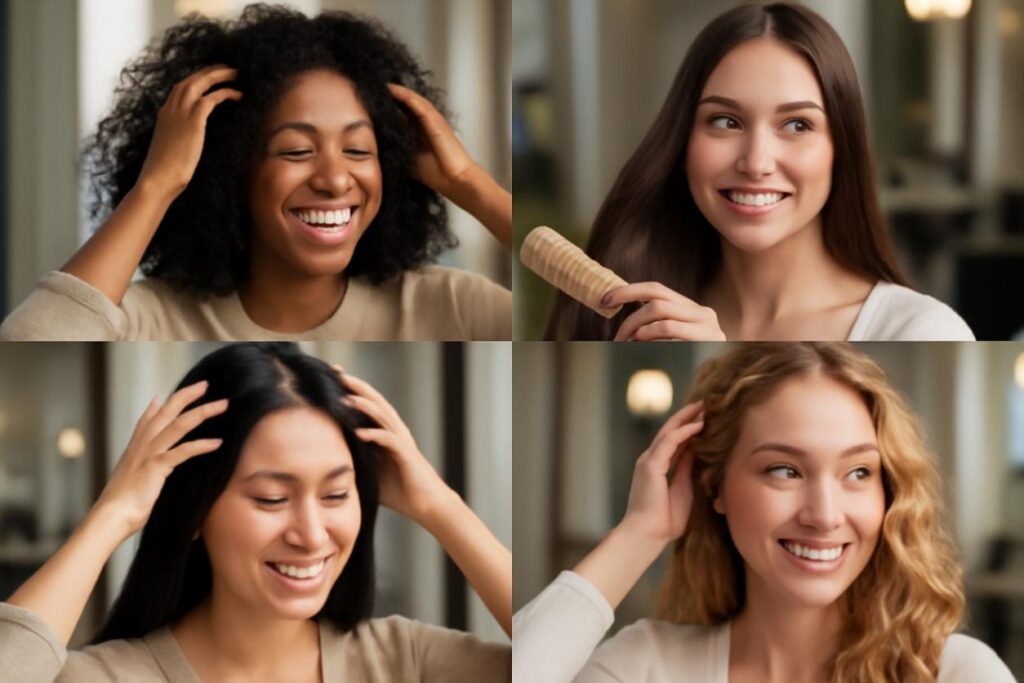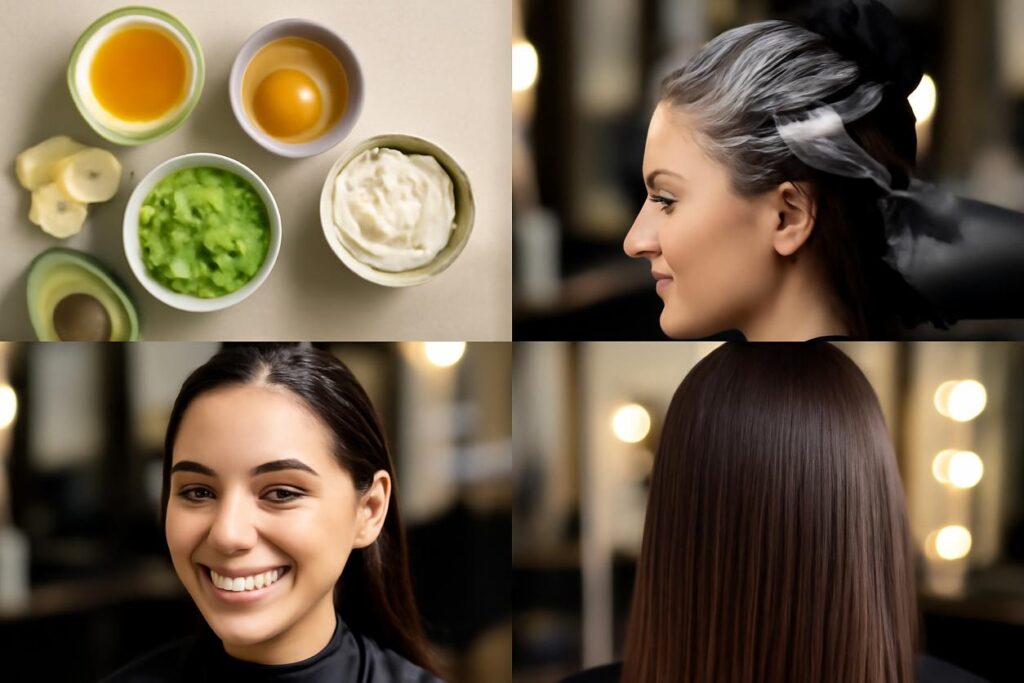Your Complete Guide to Hair Growth: Science-Backed Strategies for Healthier, Longer Hair
Have you ever wondered why some people seem to grow long, healthy hair effortlessly while others struggle to gain an inch? The journey to achieving your hair goals can feel confusing, but it doesn’t have to be. The secret isn’t a single “miracle” product; it’s a consistent, holistic approach rooted in understanding how your hair actually works. True, sustainable hair growth is a combination of internal health, gentle daily habits, and smart styling choices. This guide will demystify the process, providing you with evidence-based, actionable steps to support your hair from root to tip.
Table of Contents
- How Hair Actually Grows: The Cycle Explained
- Fueling Your Strands: Nutrients for Steady Hair Growth
- Daily Habits to Minimize Breakage and Maximize Length
- The Foundation of Growth: Scalp-First Routines
- Styling for Success: Choices That Encourage Length Retention
- A Look at Supplements: What the Evidence Says
- Common Hair Growth Myths, Busted
- Your Action Plan: A 4-Week and 12-Week Hair Growth Routine
- How to Track Your Hair Growth Progress
- When to Seek Help: Troubleshooting Your Hair Growth Journey
- Resources and Further Reading
How Hair Actually Grows: The Cycle Explained
Before we dive into strategies, it’s crucial to understand the biological process happening on your scalp. Hair doesn’t grow continuously. Each of the roughly 100,000 follicles on your head operates on its own timeline, cycling through three distinct phases. Understanding this cycle helps set realistic expectations for your hair growth journey.
The Three Main Phases of Hair Growth
- Anagen (The Growing Phase): This is the active growth phase where cells in the hair root divide rapidly, forming a new hair shaft. Hair grows about half an inch per month during this time. For the hair on your head, this phase can last anywhere from 2 to 7 years. The length of your anagen phase is largely determined by genetics and is the primary factor in how long your hair can ultimately grow.
- Catagen (The Transition Phase): Following the anagen phase, the hair follicle enters a short transitional stage that lasts about 2-3 weeks. During this time, hair growth stops, and the outer root sheath shrinks and attaches to the root of the hair.
- Telogen (The Resting Phase): This is the final phase, lasting around 3 months. The hair follicle is completely at rest, and the club hair is fully formed. At the end of this phase, the hair is shed, and the follicle re-enters the anagen phase to begin growing a new hair. Shedding 50-100 hairs per day is a normal part of this cycle.
Because each follicle is independent, you won’t see dramatic changes overnight. The key to visible progress is nurturing the follicles during the anagen phase and preventing the hair you already have from breaking.
Fueling Your Strands: Nutrients for Steady Hair Growth
Your hair follicles are tiny, highly active factories that require a steady supply of energy and nutrients to build strong hair. What you eat directly impacts the health and strength of your new hair growth. A balanced diet is the cornerstone of any effective hair care plan.
Key Nutrients for Your Hair Follicles
- Protein: Hair is made almost entirely of a protein called keratin. A lack of protein in your diet can cause hair to become brittle and weak. Include lean meats, fish, eggs, dairy, legumes, and nuts.
- Iron: Iron deficiency (anemia) is a major cause of hair loss, particularly in women. Iron helps red blood cells carry oxygen to your cells, including your hair follicles. Good sources include red meat, spinach, lentils, and fortified cereals.
- Zinc: This mineral plays a vital role in hair tissue growth and repair. It also helps keep the oil glands around the follicles working properly. Find it in oysters, beef, pumpkin seeds, and lentils.
- Biotin and B-Vitamins: Biotin is well-known for its role in hair health. Other B-vitamins help create red blood cells, which carry oxygen and nutrients to the scalp and hair follicles, processes critical for hair growth. Whole grains, almonds, meat, and dark, leafy greens are excellent sources.
- Vitamin C: This antioxidant helps your body absorb iron and is crucial for creating collagen, a protein that contributes to hair strength. Berries, citrus fruits, and bell peppers are packed with Vitamin C.
- Vitamins D & E: Low levels of Vitamin D have been linked to hair loss, while Vitamin E is a powerful antioxidant that can help protect against oxidative stress. Get Vitamin D from sunlight and fortified foods, and Vitamin E from sunflower seeds, almonds, and avocados.
For a deeper dive into how diet impacts hair, this Nutrition and Hair Health Review from the NCBI is an excellent resource. The goal is to nourish your body with a variety of whole foods, not to follow a restrictive diet.
Daily Habits to Minimize Breakage and Maximize Length
The hair you see is no longer biologically active. This means you can’t “heal” it, but you can protect it from damage. Preventing breakage is just as important as encouraging new growth from the scalp. This concept is called length retention.
Gentle Washing and Conditioning
Focus shampoo on your scalp, where oil and dirt accumulate. Allow the suds to run down the lengths of your hair as you rinse. Use lukewarm water, as very hot water can strip your hair and scalp of essential oils. Always follow up with a conditioner, concentrating it on the mid-lengths and ends to restore moisture and reduce friction.
The Art of Detangling
Never rip a brush through tangled hair. Wet hair is more fragile, so be extra cautious. Apply conditioner or a detangling spray to provide slip, then use a wide-tooth comb or your fingers to gently work through knots, starting from the bottom and moving upward toward the roots. This method prevents you from tightening knots and causing breakage.
Drying Without Damage
Aggressively rubbing your hair with a coarse cotton towel creates friction that can rough up the hair cuticle and lead to frizz and breakage. Instead, gently squeeze out excess water with a soft microfiber towel or an old t-shirt. Let your hair air-dry whenever possible to minimize heat exposure.
The Foundation of Growth: Scalp-First Routines
A healthy scalp is the garden from which healthy hair grows. If your scalp is clogged, inflamed, or unhealthy, it can impede proper hair growth. A scalp-first approach is non-negotiable.
Cleansing Your Scalp Effectively
Just like the skin on your face, your scalp needs to be clean to function optimally. Product buildup, dead skin cells, and excess sebum can clog follicles. Use your fingertips (not your nails) to gently massage shampoo into your scalp to lift away debris without causing irritation or stripping its natural moisture barrier.
The Power of Scalp Massage
A gentle scalp massage can be a relaxing ritual that also benefits your hair. The practice is thought to increase blood circulation to the follicles, potentially delivering more oxygen and nutrients. Using the pads of your fingers, apply light to medium pressure on your scalp, moving in small circular motions for 3-5 minutes a few times a week.
Avoiding Irritation
Pay attention to how your scalp feels. Itching, redness, or excessive flaking can be signs of irritation from harsh product ingredients or an underlying condition. Avoid scratching your scalp, as this can damage the follicles and the hair shaft.
Styling for Success: Choices That Encourage Length Retention
How you style your hair can either support or sabotage your hair growth goals. The aim is to minimize stress, friction, and tension on your strands.
Heat Styling Smarter
High heat is a primary culprit of hair damage. If you use heat tools, always apply a heat protectant spray first. Use the lowest temperature setting that effectively styles your hair, and try to limit heat styling to once or twice a week at most.
Protective Styling Options
Protective styles are any hairstyle that tucks away the ends of your hair, protecting them from daily manipulation and environmental damage. Options include loose braids, twists, buns, and updos. The critical rule is that these styles should never be tight. Constant pulling can lead to a type of hair loss called traction alopecia.
Swapping Your Tools and Accessories
- Sleep on Silk or Satin: Cotton pillowcases can cause friction and absorb moisture from your hair. A silk or satin pillowcase or bonnet provides a smooth surface, reducing tangles and breakage while you sleep.
- Choose Gentle Hair Ties: Tight elastic bands with metal clasps can snag and break hair. Opt for gentle options like scrunchies, spiral hair ties, or seamless fabric bands.
A Look at Supplements: What the Evidence Says
The supplement aisle is filled with products promising rapid hair growth. While tempting, it’s important to approach them with a healthy dose of skepticism. Supplements are most effective when they are correcting a specific nutritional deficiency that is contributing to hair loss. For most people with a balanced diet, mega-doses of vitamins will not magically speed up the hair growth cycle.
Evaluating Supplement Claims
Before taking any supplement, it is best to consult with a healthcare professional who can perform blood tests to check for deficiencies in nutrients like iron, vitamin D, or zinc. If you do choose a supplement, look for third-party certifications (like USP or NSF) on the label, which verify that the product contains what it claims to contain without harmful contaminants.
Common Hair Growth Myths, Busted
Misinformation about hair growth is rampant. Let’s clear up a few common myths.
- Myth: Trimming your hair makes it grow faster from the root.
- Fact: A haircut has no effect on the biological process happening at the follicle. However, regular trims (every 8-12 weeks) are essential for length retention. They remove split ends before they can travel up the hair shaft and cause more significant breakage, making your hair appear thicker and healthier.
- Myth: Special shampoos can speed up your natural growth rate.
- Fact: No topical product can change your genetically determined hair growth cycle. However, shampoos formulated for scalp health can create a better environment for growth by removing buildup and reducing inflammation, which indirectly supports the process.
- Myth: You should brush your hair 100 strokes a day for health and shine.
- Fact: Excessive brushing can cause significant mechanical damage, friction, and breakage. Brush your hair only as much as needed to detangle and style it, and always do so gently.
Your Action Plan: A 4-Week and 12-Week Hair Growth Routine
Consistency is key. Use these simple, actionable checklists to build healthy habits over time. This plan is designed to be adopted starting in 2025 or beyond.
Your 4-Week “Micro-Routine” Kickstart
Focus on one new habit each week to avoid feeling overwhelmed.
| Week | Focus Area | Actionable Goal |
|---|---|---|
| Week 1 | Gentle Handling | Start detangling from the ends up. Swap your cotton towel for a microfiber one. |
| Week 2 | Scalp Care | Incorporate a 3-minute scalp massage three times this week. |
| Week 3 | Nutrition Boost | Add one hair-healthy food (like spinach, eggs, or berries) to your daily meals. |
| Week 4 | Nighttime Protection | Switch to a silk or satin pillowcase or start wearing a protective bonnet to bed. |
The 12-Week Sustained Hair Health Plan
After establishing your foundation, build upon it for long-term success.
- Months 1-3 Focus: Make the habits from your 4-week kickstart second nature.
- Action Checklist:
- Master one or two go-to protective hairstyles that are comfortable and don’t pull on your scalp.
- Assess your washing schedule. Is your scalp clean but not stripped? Adjust as needed.
- Commit to using a heat protectant every single time you use heat tools. Better yet, challenge yourself to one heat-free week per month.
- Take your first set of progress photos to set a baseline.
How to Track Your Hair Growth Progress
Tracking your journey helps you stay motivated and see what’s working. Since growth is slow, focusing on the right metrics is important.
Simple Metrics to Watch
- Length Checks: Once a month, gently pull a section of hair from the front to a fixed point (like your chin, collarbone, or shoulder) and note its length. Don’t obsess over daily changes.
- Shedding Observation: It’s normal to shed hair. However, pay attention to a significant, sustained increase in the amount of hair you see in your brush or the shower drain.
- Condition and Feel: Notice the qualitative changes. Does your hair feel softer? Is it shinier? Do you see fewer split ends? These are all signs of improved health.
Photo-Log Tips
A picture is worth a thousand words. To create a useful photo log, take pictures once every 3 months. Ensure consistency by using the same lighting, background, and camera angle each time. Take photos of the back, sides, and your hairline.
When to Seek Help: Troubleshooting Your Hair Growth Journey
While lifestyle changes can significantly improve hair health, some issues require professional medical advice. It’s important to distinguish between normal variations and signs of an underlying problem.
Signs That Warrant a Doctor’s Visit
- A sudden increase in shedding or hair falling out in clumps.
- The appearance of bald patches or significant thinning.
- A persistently itchy, painful, or inflamed scalp.
- Hair loss that accompanies other symptoms like fatigue or changes in weight.
If you experience any of these, it’s time to consult a doctor or a dermatologist. They can help diagnose the root cause, which could be anything from a thyroid issue to an autoimmune condition. For reliable information, consult the NHS Hair Loss Guidance and the American Academy of Dermatology — Hair Loss Overview.
Resources and Next Steps
Embarking on a hair growth journey is a marathon, not a sprint. The most impactful changes come from small, consistent habits that you can maintain over the long term. Focus on nourishing your body from the inside, protecting your hair from damage on the outside, and treating your scalp with care. Be patient with yourself and your hair, and celebrate the small victories in health and strength along the way.






